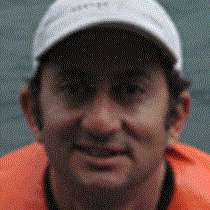South Plaza Island
Early in the morning we anchored near two large lava outcrops, very close to the eastern shores off Santa Cruz Island: The Plaza Islets. Our land visit, on South Plaza’s trail was most memorable.
South Plaza Island, as it is also referred to, is a true, living, laboratory of evolution. Today, we were all spectators of a behavior that naturalist have described, told tales, and argued about for many years. Not many have been lucky to witness the predation of a seabird by a Galápagos land iguana; we were amazed onlookers as we observed it today. Aura, our fellow naturalist was all over the handheld radio, calling us as the adult Galapagos shearwater was being mauled to death by the male iguana. A behavior that, as far as we know, has never been photographed before.
The visit was going well, the usual Galápagos stuff, as I always joke about with visitors: land iguana nesting grounds and territories, giant cacti forest, flying blue-footed boobies and red billed tropicbirds, gliding frigate birds and shearwaters, nesting swallow tailed gulls with chicks, lava lizards displaying, singing warblers and many species of mat plants, most of them flowering. And then the call took place. We all moved to the location and, excitedly told everybody about how amazing this was, as we eyed the action attentively.
I think the iguanas, somehow, know that these tube nostril birds, heavy from their macro plankton and oil load, encounter turbulence on the sustaining updraft, miscalculating sometimes and hitting the ground…where they are absolutely defenseless. Shearwaters have an interesting body balance; their small webbed feet far back their bodies, perfect for a running take off from the surface of the ocean, very bad for land use. As they crawl to the edge of the cliff, the iguanas, capable of fast runs, will then catch the bird, move to a neck or head hold, to patiently smother its catch. The iguana does not have any other way to kill the bird, having the denture of an herbivorous species. It didn’t look as it had any problems ripping the flesh apart, and it didn’t look as it was “its first rodeo.”
The living laboratory was on, as it has been for many hundreds of thousands of years.
The afternoon took us to Santa Fe Island, here we snorkeled in a bay of turquoise waters, a natural aquarium with sea lions, eagle rays, and scores of reef fish. Then we walked up to the top of the island, looking for another species of land iguana which is endemic to Santa Fe, and very different from the morning’s type…yet another example of the Galapagos’ unique lineages.
A view from the top of the ridge was a great way to end an awesome day.




